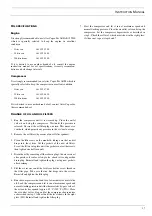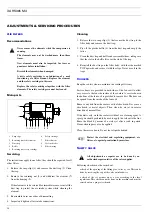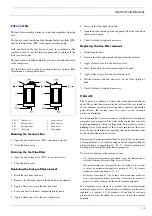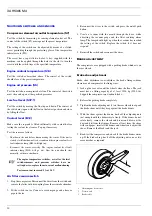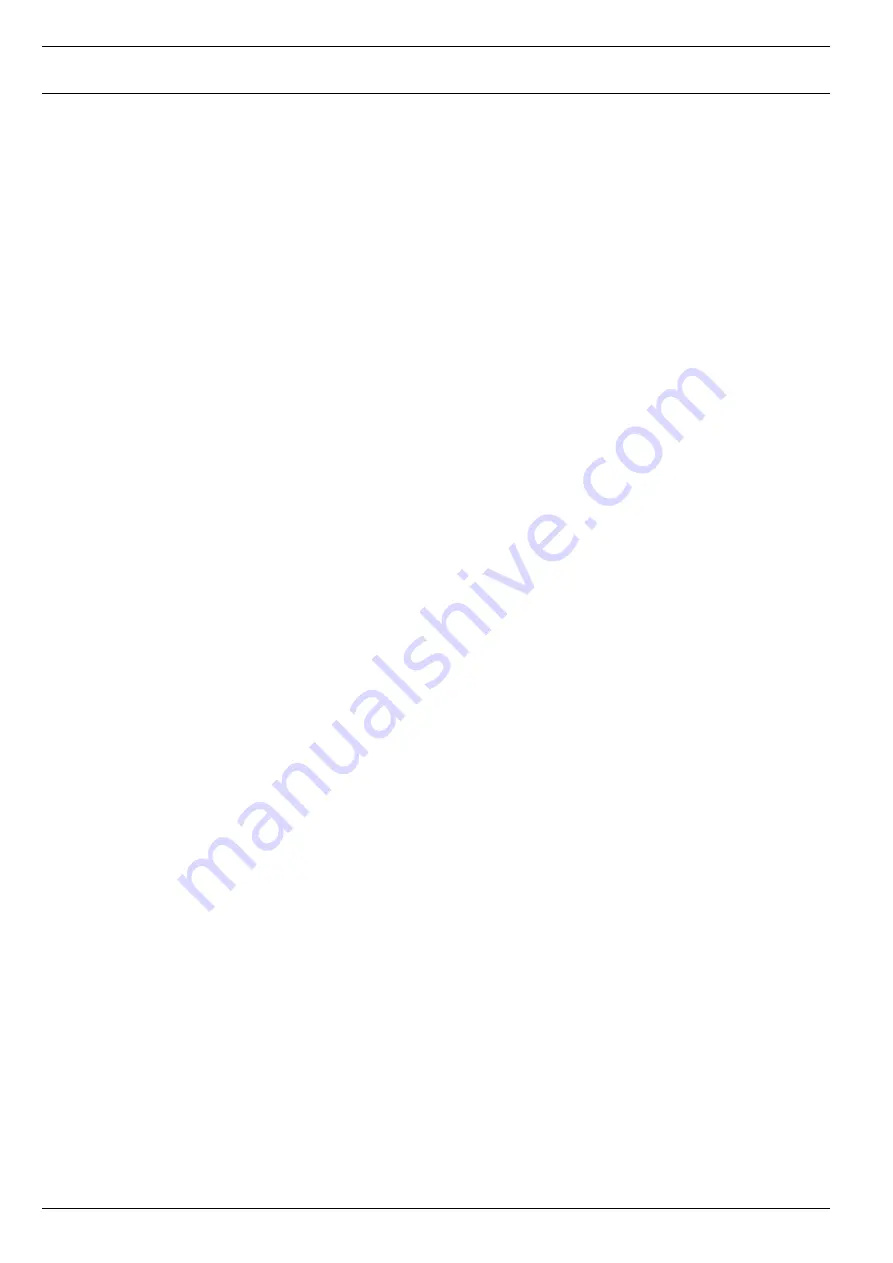
XAHS365 Md
6
14 All doors shall be shut during operation so as not to disturb the cooling air
flow inside the bodywork and/or render the silencing less effective. A door
should be kept open for a short period only e.g. for inspection or
adjustment.
15 Periodically carry out maintenance works according to the maintenance
schedule.
16 Stationary housing guards are provided on all rotating or reciprocating
parts not otherwise protected and which may be hazardous to personnel.
Machinery shall never be put into operation, when such guards have been
removed, before the guards are securely reinstalled.
17 Noise, even at reasonable levels, can cause irritation and disturbance
which, over a long period of time, may cause severe injuries to the nervous
system of human beings.
When the sound pressure level, at any point where personnel normally has
to attend, is:
below 70 dB(A):
no action needs to be taken,
above 70 dB(A):
noise-protective devices should be provided for people
continuously being present in the room,
below 85 dB(A):
no action needs to be taken for occasional visitors
staying a limited time only,
above 85 dB(A):
room to be classified as a noise-hazardous area and an
obvious warning shall be placed permanently at each
entrance to alert people entering the room, for even
relatively short times, about the need to wear ear
protectors,
above 95 dB(A):
the warning(s) at the entrance(s) shall be completed
with the recommendation that also occasional visitors
shall wear ear protectors,
above 105 dB(A): special ear protectors that are adequate for this noise
level and the spectral composition of the noise shall be
provided and a special warning to that effect shall be
placed at each entrance.
18 Insulation or safety guards of parts the temperature of which can be in
excess of 80 °C (175 °F) and which may be accidentally touched by
personnel shall not be removed before the parts have cooled to room
temperature.
19 Never operate the unit in surroundings where there is a possibility of
taking in flammable or toxic fumes.
20 If the working process produces fumes, dust or vibration hazards, etc., take
the necessary steps to eliminate the risk of personnel injury.
21 When using compressed air or inert gas to clean down equipment, do so
with caution and use the appropriate protection, at least safety glasses, for
the operator as well as for any bystander. Do not apply compressed air or
inert gas to your skin or direct an air or gas stream at people. Never use it
to clean dirt from your clothes.
22 When washing parts in or with a cleaning solvent, provide the required
ventilation and use appropriate protection such as a breathing filter, safety
glasses, rubber apron and gloves, etc.
23 Safety shoes should be compulsory in any workshop and if there is a risk,
however small, of falling objects, wearing of a safety helmet should be
included.
24 If there is a risk of inhaling hazardous gases, fumes or dust, the respiratory
organs must be protected and depending on the nature of the hazard, so
must the eyes and skin.
25 Remember that where there is visible dust, the finer, invisible particles will
almost certainly be present too; but the fact that no dust can be seen is not
a reliable indication that dangerous, invisible dust is not present in the air.
26 Never operate the unit at pressures or speeds below or in excess of its
limits as indicated in the technical specifications.
S
AFETY
DURING
MAINTENANCE
AND
REPAIR
Maintenance, overhaul and repair work shall only be carried out by adequately
trained personnel; if required, under supervision of someone qualified for the
job.
1
Use only the correct tools for maintenance and repair work, and only tools
which are in good condition.
2
Parts shall only be replaced by genuine Atlas Copco replacement parts.
3
All maintenance work, other than routine attention, shall only be
undertaken when the unit is stopped. Steps shall be taken to prevent
inadvertent starting. In addition, a warning sign bearing a legend such as
”work in progress; do not start” shall be attached to the starting equipment.
On engine-driven units the battery shall be disconnected and removed or
the terminals covered by insulating caps.
On electrically driven units the main switch shall be locked in open
position and the fuses shall be taken out. A warning sign bearing a legend
such as ”work in progress; do not supply voltage” shall be attached to the
fuse box or main switch.
4
Before dismantling any pressurized component, the compressor or
equipment shall be effectively isolated from all sources of pressure and the
entire system shall be relieved of pressure. Do not rely on non-return
valves (check valves) to isolate pressure systems. In addition, a warning
sign bearing a legend such as ”work in progress; do not open” shall be
attached to each of the outlet valves.
5
Prior to stripping an engine or other machine or undertaking major
overhaul on it, prevent all movable parts from rolling over or moving.
6
Make sure that no tools, loose parts or rags are left in or on the machine.
Never leave rags or loose clothing near the engine air intake.
7
Never use flammable solvents for cleaning (fire-risk).
8
Take safety precautions against toxic vapours of cleaning liquids.
9
Never use machine parts as a climbing aid.
10 Observe scrupulous cleanliness during maintenance and repair. Keep away
dirt, cover the parts and exposed openings with a clean cloth, paper or
tape.
11 Never weld on or perform any operation involving heat near the fuel or oil
systems. Fuel and oil tanks must be completely purged, e.g. by steam-
cleaning, before carrying out such operations. Never weld on, or in any
way modify, pressure vessels. Disconnect the alternator cables during arc
welding on the unit.
12 Support the towbar and the axle(s) securely if working underneath the unit
or when removing a wheel. Do not rely on jacks.
13 Do not remove any of, or tamper with, the sound-damping material. Keep
the material free of dirt and liquids such as fuel, oil and cleansing agents.
If any sound-damping material is damaged, replace it to prevent the sound
pressure level from increasing.
14 Use only lubricating oils and greases recommended or approved by Atlas
Copco or the machine manufacturer. Ascertain that the selected lubricants
comply with all applicable safety regulations, especially with regard to
explosion or fire-risk and the possibility of decomposition or generation of
hazardous gases. Never mix synthetic with mineral oil.
15 Protect the engine, alternator, air intake filter, electrical and regulating
components, etc., to prevent moisture ingress, e.g. when steam-cleaning.
16 When performing any operation involving heat, flames or sparks on a
machine, the surrounding components shall first be screened with non-
flammable material.
17 Never use a light source with open flame for inspecting the interior of a
machine.
Summary of Contents for XAHS365 Md
Page 2: ...XAHS365 Md 2 ...
Page 38: ......
Page 39: ...Printed in Belgium 10 2000 2927 1233 03 ...
Page 40: ...Instruction Manual for Portable Compressors XAHS365 Md ...

















